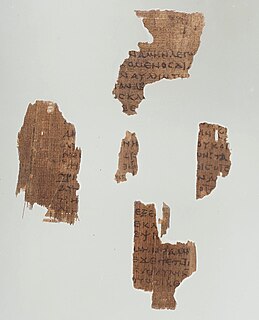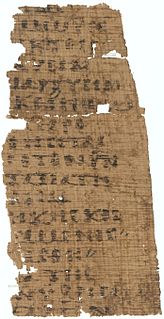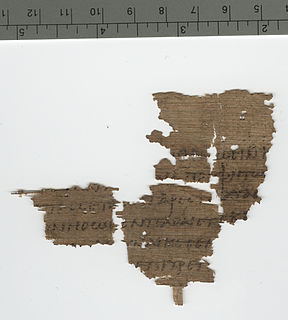
The Codex Washingtonianus or Codex Washingtonensis, designated by W or 032, ε 014 (Soden), also called the Washington Manuscript of the Gospels, and The Freer Gospel, contains the four biblical gospels and was written in Greek on vellum in the 4th or 5th century. The manuscript is lacunose.

Codex Tischendorfianus II – designated by Uncial 081 α 1023 (Soden), – is a Greek uncial manuscript of the New Testament, dated paleographically to the 6th century.
Uncial 088, α 1021 (Soden), is a Greek uncial manuscript of the New Testament, dated paleographically to the 5th or 6th century.

Papyrus 6, designated by 6 or by ε 021, is a fragmentary early copy of the New Testament in Greek and Coptic (Akhmimic). It is a papyrus manuscript of the Gospel of John that has been dated paleographically to the 4th century. The manuscript also contains text of the First Epistle of Clement, which is treated as a canonical book of the New Testament by the Coptic Church. The major part of the codex is lost.
Papyrus 19, signed by 19, is an early copy of the New Testament in Greek. The manuscript paleographically has been assigned to the 4th or 5th century.

Papyrus 49 (Gregory-Aland), designated by 49, is an early copy of the New Testament in Greek. It is a papyrus manuscript of the Epistle to the Ephesians, surviving in a fragmentary condition. The manuscript has been palaeographically assigned to the 3rd century. It was probably a part of the same manuscript as Papyrus 65. It came from Egypt and was purchased for the Yale University Library. Textually it is close to the Codex Sinaiticus and Codex Vaticanus. The text of the manuscript has been published several times.
Papyrus 62, signed by 62, known also as ‘‘Papyrus Osloensis’’, is a copy of the New Testament and Septuagint in Greek-Coptic. It is a papyrus manuscript of the Gospel of Matthew and Book of Daniel. The manuscript palaeographically has been assigned to the 4th century.

Papyrus 63, designated by 63, is a copy of the New Testament in Greek. It is a papyrus manuscript of the Gospel of John. The surviving text of John are verses 3:14-18; 4:9-10. The manuscript paleographically had been assigned to the 4th century.

Papyrus 79, designated by 79, is a copy of the New Testament in Greek. It is a papyrus manuscript of the Epistle to the Hebrews. The surviving texts of Hebrews are verses 10:10-12,28-30.
Uncial 0165, is a Greek uncial manuscript of the New Testament, dated paleographically to the 5th century.

Papyrus 123, designated by 123, is an early copy of the New Testament in Greek. It is a papyrus manuscript of the First Epistle to the Corinthians.
Uncial 0259, is a Greek uncial manuscript of the New Testament. Paleographically it has been assigned to the 7th century. The codex contains some parts of the 1 Timothy 1:4-5.6-7, on 2 parchment leaves. Written in one column per page, 11 lines per page, in uncial letters.
Uncial 0260, is a Greek-Coptic uncial manuscript of the New Testament. Palaeographically it has been assigned to the 6th century. The manuscript has survived in a very fragmentary condition.
Uncial 0261, is a Greek uncial manuscript of the New Testament. Palaeographically it has been assigned to the 5th century. The manuscript has survived in a very fragmentary condition.
Uncial 0263, is a Greek uncial manuscript of the New Testament. Paleographically, it has been assigned to the 6th century.
Uncial 0264, is a Greek uncial manuscript of the New Testament. Paleographically it has been assigned to the 5th century.
Uncial 0265, is a Greek uncial manuscript of the New Testament. Palaeographically it has been assigned to the 6th century.
Uncial 0266, is a Greek uncial manuscript of the New Testament. Paleographically it has been assigned to the 6th century.
Minuscule 343, ε 120 (Soden), is a Greek minuscule manuscript of the New Testament, on parchment. Palaeographically it has been assigned to the 11th century. It has full marginalia.
Minuscule 566, ε 93 (Soden), also known as the Empress Theodora's Codex. It is a Greek minuscule manuscript of the New Testament, on parchment, dated palaeographically to the 9th century.












